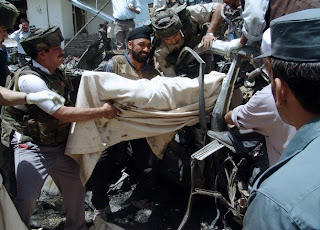
Amongst the victims of the blast were the Indian defence attaché, Brigadier RD Mehta, and a senior Indian External Affairs official, Counsellor V Rao.
Since the tragedy, investigations by both Indian and American intelligence agencies have traced the blasts back to Pakistan's notorious ISI, or Inter-services Intelligence Agency. This latest attack only seemed to compound the idea that Indo-Pakistani rivalry in Afghanistan has been gradually escalating in its intensity over the past few years.
Their competition is hardly a new phenomenon, as both countries have had conflicting strategic agendas in the region for decades.
Pakistani military strategists have traditionally viewed the establishment of strategic ties with Afghanistan as a way of obtaining 'strategic depth' in the event of an all-out war with India.The Taliban were aided and abetted by Pashtun field officers of the ISI in their rise to prominence over other warring factions in the 90s. Meanwhile, India attempted to dilute Pakistani influence in the region by bankrolling the Northern Alliance, led at the time by the charismatic Tadjik leader Ahmad Shah Massoud.
While the fall of the Taliban in 2001 was a catastrophe in the eyes of many in the Pakistani intelligence community, it was perceived as a wonderful window of opportunity for their Indian counterparts to regain Delhi's lost footing in the region.
And indeed, immediately after the fall of the Taliban, India moved with lightning speed to reassert its influence in the region. Four consulates have been opened, in Mazar-e-Sharif, Herat, Jalalabad and Kandahar, and Afghanistan has become India's second biggest foreign aid commitment, with over 750 million dollars spent in aid over the past few years.
New Delhi has poured funds into education, food aid, and health services. The Power Grid Corporation of India is setting up power lines over the Hindu Kush, and Indian firms are active all over the country, whether it be in the building of more than 200km of roads, the erecting of bridges or the digging of wells. Several Indian NGOs are also engaged in humanitarian work throughout the country. Bollywood has become wildly popular in Afghan households, despite the strenuous efforts of some the more conservative mullahs to get the 'licentious Indian films' banned.
Bilateral trade has grown rapidly, and now accounts for more $225m.
This spurt of economic activity is not only part of an elaborate 'hearts and minds' campaign designed to wean the fragile country from Islamabad's influence. For both India and Pakistan, Afghanistan is a gateway to Central Asian oil and natural gas. Delhi, however, is constrained in its ambitions to expand trade with Kabul, as Pakistan continues to block the transit of Indian goods through its territory. Currently, most of Afghanistan's trade has to pass through the Pakistani ports of Gwadar and Karachi. In order to counter Islamabad's stranglehold on Afghan trade, Delhi has been erecting a port in Chabahar in Iran which would enable it to transport Indian goods to Afghanistan while completely bypassing Pakistan.

The latter, however, views the construction of Chabahar as India's latest attempt to encircle Pakistan in the region after the recent establishment of the Indian Air Force's base in Farkho; Tadjikistan, which is said to house MI-17 helicopter gunships. While India has not deployed troops as part of Operation Enduring Freedom in Afghanistan, it has nevertheless expanded its military presence in the country, taking the decision in 2006 to send several hundred paramilitary troops, allegedly to protect Indian workers and contractors.
All this has resulted in Pakistan becoming increasingly jittery over what it perceives to be tantamount to an Indian takeover of its backyard. Over the past few years, Indian workers have been repeatedly abducted, and sometimes murdered; and grenades have been lobbed at the Indian consulates in Herat and Jalalabad. Although each time the Taliban were accused of the misdeeds, several members of the Indian security establishment harbour the suspicion that Adam Khan, the shadowy Kabul station head of the ISI, may be involved in the attacks.
On the other side, Pakistani officials have repeatedly accused Indian RAW (Research and Analysis Wing) agents of establishing training camps in southern Afghanistan and the Panjshir Valley for the rebels of the Baloch Liberation Army, who are waging a separatist insurgency in Pakistan's troubled Baluchistan province. The Indian consulates have also frequently been charged with circulating counterfeit Pakistani currency.
(See here the interview of Pakistani Senator Mushahid Hussain in May 2006: http://www.boloji.com/analysis2/0116.htm)
One could hope that with the advent of a more democratic form of government in Pakistan, tensions in the region might somewhat subside, and that Afghanistan would no longer be the centrepiece in the Indo-Pakistani 'great game' in Central Asia. Unfortunately, it is my opinion that Pakistan's growing internal instability, when combined with the resurgence of the Taliban in the Pashtun dominated southern regions , leads to an adverse conclusion.
To read more about the geopolitical ramifications of the overthrow of the Taliban regime, I strongly recommend the latest book by Pakistani journalist Ahmed Rashid, "Descent into Chaos, the United States, and the Failure of Nation Building in Pakistan, Afghanistan and Central Asia".
It's a very insightful, informative, and often rather gripping study of the aftermath of the US-led intervention in Afghanistan.
http://www.amazon.com/Descent-into-Chaos-Building-Afghanistan/dp/0670019704/ref=sr_1_1?ie=UTF8&s=books&qid=1225302861&sr=8-1




